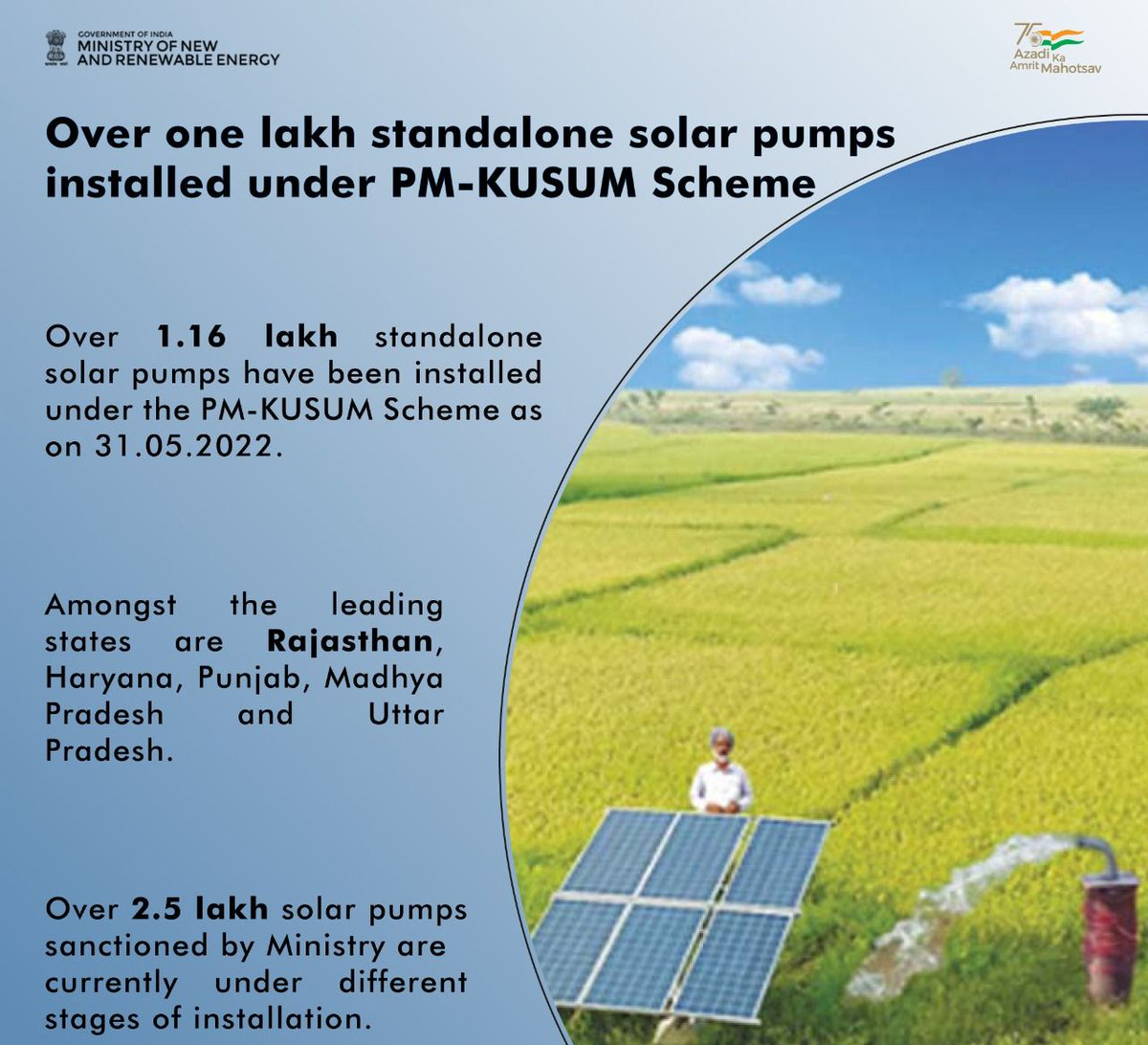PM KUSUM | 04 Feb 2023
Prelims: PM KUSUM, Off-grid solar pumps, Solar Energy, Renewable Energy, Empowerment of Agriworkers.
Mains: PM KUSUM, its Significance and Challenges.
Why in News?
The Ministry of New and Renewable Energy (MNRE) has extended the deadline to install 30,000 MW solar power capacity in rural India to March 2026 under PM-KUSUM (Pradhan Mantri Kisan Urja Suraksha Evam Uttham Mahabhiyan).
What is PM KUSUM?
- About:
- The PM-KUSUM was launched by the MNRE in 2019, in order to endow installation of off-grid solar pumps in rural areas and reduce dependence on grid, in grid-connected areas.
- Components:
- 10,000 MW of decentralized ground-mounted grid-connected renewable power plants.
- Installation 20 lakh solar-powered agriculture pumps
- Converting 15 lakh agriculture pumps, already connected to the grid, into solar.
- Objective:
- It aims to enable farmers to set up solar power generation capacity on their arid lands and to sell it to the grid.
- It also seeks to increase the income of farmers by allowing them to sell surplus solar power to the grid.
- Achievements:
What is the Significance of the Scheme?
- Increase Access to Energy:
- It incentivises the farmers to sell surplus solar energy to the states, which in turn will augment their income.
- The scheme is expected to increase access to electricity in rural areas and provide a reliable source of energy for agriculture and other rural activities
- Contain Climate Catastrophe:
- If farmers are able to sell surplus power, they will be incentivised to save power and, in turn, it will mean the reasonable and efficient use of groundwater.
- Also, expansion of the irrigation cover by providing decentralized solar-based irrigation and moving away from polluting diesel.
- When implemented fully, PM-KUSUM will lead to reducing carbon emissions by as much as 32 million tonnes of CO2 per annum.
- Employment and Empowerment:
- The scheme is expected to create job opportunities in the installation, maintenance, and operation of solar power projects.
- The scheme is expected to empower rural communities by giving them control over their own energy generation and distribution.
What are the Associated Challenges?
- Financial and Logistics Issue:
- The cost of setting up solar power projects can be high, and some farmers may not have access to the necessary financing.
- There is a matter of domestic availability of equipment itself. While pumps are not a challenge for domestic suppliers, the availability of solar pumps is still an issue.
- Depleting Water Tables:
- Due to power subsidies, the recurring cost of electricity is so low that farmers keep on pumping water and the water table is going down.
- In a solar installation, it becomes a more difficult job to upgrade to higher capacity pumps in case the water table falls because one will have to add new solar panels which are expensive.
- Regulatory Barriers and Stability:
- There may be regulatory barriers that prevent the smooth implementation of the scheme, such as restrictions on the connection of solar power projects to the grid.
- Integrating decentralized solar power projects into the grid may pose technical challenges and stability issues, which need to be addressed.
Way Forward
- Consensus between the Centre and States is the key to the success of this decentralised solar power scheme. Any reform in India’s power space cannot take place unless there is consensus between the Centre, States and stakeholders.
- Apart from switching to solar power, farmers should also switch over to drip irrigation mode which saves water and power with increased crop output.
- For effective implementation and serious participation by stakeholders, the scheme should be more attractive in terms of benchmark prices in view of the challenges on account of higher costs of implementation and comprehensive maintenance.
UPSC Civil Services Examination Previous Year Question (PYQ)
Prelims
Q. Consider the following statements: (2016)
- The International Solar Alliance was launched at the United Nations Climate Change Conference in 2015.
- The Alliance includes all the member countries of the United Nations.
Which of the statements given above is/are correct?
(a) 1 only
(b) 2 only
(c) Both 1 and 2
(d) Neither 1 nor 2
Ans: (a)
Exp:
- India and France launched the International Solar Alliance (ISA) to boost solar energy in developing countries.
- It was launched at the United Nations Climate Change Conference in Paris in November 2015 by the Indian Prime Minister and French President. Its secretariat is located in Gurugram, India. Hence, statement 1 is correct.
- At initial stage ISA was opened to membership of countries lying fully or partly between the Tropics of Cancer and Capricorn (torrid zone).
- In 2018, the membership of ISA was opened for all the UN members. However, all the member countries of the UN are not its members. Hence, statement 2 is not correct.
- Currently, 80 countries have signed and ratified the ISA Framework Agreement while 98 countries have signed the ISA Framework Agreement. Therefore, option (a) is the correct answer.
Mains
Q. India has immense potential of solar energy though there are regional variations in its developments. Elaborate (2020)

